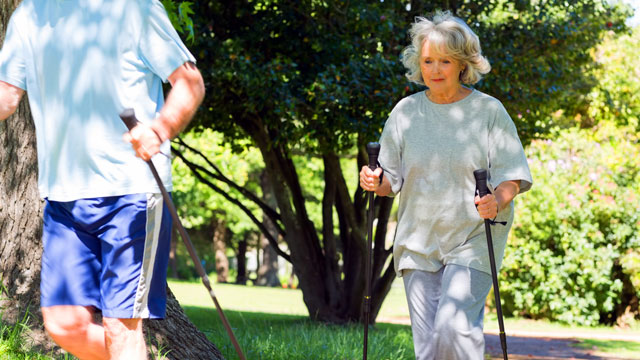
Arthritis is not really a specific disease but a condition—general inflammation and pain in a joint. Inflammation has any one of over a hundred causes, ranging from viral and bacterial infection to bad nutrition, to the side-effects of certain medications. This is why many problems known as arthritis (thought to be incurable, inevitable scourges of old age) are very often afflictions that are highly treatable. (1,5)
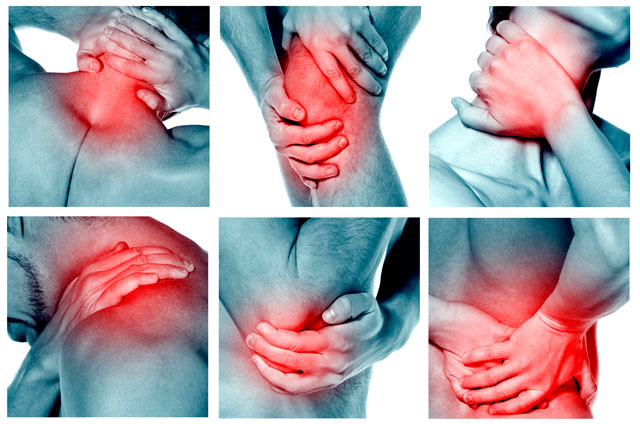
Medical science has identified over one hundred different types of arthritis and that number continues to increase. Newer research has given us a deeper appreciation of many factors that figure into the inflammatory condition. (1)
Inflammation may be confined to a small part of the body, as in a joint (arthritis) or tendon (tendinitis), or it may be widespread (as in rheumatoid arthritis). (1)
The most common forms of arthritis are:
Osteoarthritis is the most common type of arthritis as it affects over 30 million Americans and about 80% of people over 50. (3,7)
Osteoarthritis is a chronic joint disorder characterized by degeneration of joint cartilage and adjacent bone that can cause joint pain and stiffness. (3,9)
The literal Greek translation of osteoarthritis is osteo (of the bone), arthro (joint) and itis (inflammation). But "bone-joint inflammation" may not be the most accurate description of osteoarthritis, since joint pain rather than inflammation is its most important characteristic. (8)
Osteoarthritis begins in the cartilage, the rubbery, gel-like tissue found at the end of bones. Think of healthy cartilage as being something of a sponge between the hard ends of the bones. As the disease progresses the cartilage begins to soften and crack. And, of course, the more cartilage wears away, the more the bones rub together, creating greater amounts of pain, bone deformities and eventually inflammation. (8)
Cartilage is a watery substance, about 65% to 80% water. The rest is made up of collagen and proteoglycans. Collagen, a protein known for its versatility, is found in many different parts of the body, taking different forms to fulfill various functions. Collagen is a vital part of cartilage, providing it with elasticity and the ability to absorb shock. In a sense, collagen is the "glue" that holds the cartilage matrix together. (8)
Rheumatoid arthritis is a systemic disease, with chronic inflammation of the joints, muscles, ligaments and tendons. It's not a simple disease in any form, affecting not only the bones and joints, but also the blood vessels, kidneys, skin, eyes and brain. (7)
There are more than a hundred different types of rheumatic diseases, many causing different forms of arthritis. Depending upon the type of arthritis, the associated inflammation may flare up in one joint or many, may limit itself to the joint only, or might spread to the muscles, tendons, ligaments, internal organs and even the skin. (8)
Rheumatoid arthritis where the body's immune system begins attacking it's own tissues and thereby causes chronic inflammation. (5)
Most of the conventional therapies are of short-term value at best. Many make the condition worse. Rheumatoid arthritis is an example of a condition where the body is actually at war with itself (an autoimmune condition) where, for a single reason or a pattern of reasons, the immune system begins attacking the body's own tissues. In rheumatoid arthritis, antibodies develop to target the joint tissues. The result is the chronic inflammatory character of this arthritis. (5)
Gout and pseudogout are both caused by crystal deposits in the joints and both cause joint inflammation (arthritis) pain. Risk factors for gout include a family history of gout, drinking alcohol (especially beer and hard liquour), eating or drinking food and drinks high in fructose (including sodas and fruit juices), high blood pressure, taking certain medications (including diuretics), being overweight, or gaining weight. (4,8,9)
Gout (known as hyperuricemia) is when there is too much uric acid in the body. The body makes uric acid when it breaks down purines, which are manufactured in the body and in foods. Meats, particularly organ meats, are high-purine foods. As purines are metabolized, uric acid is formed. Uric acid is the final breakdown product of purines. Excess uric acid needs to be secreted. This is the kidney's job. When there is too much uric acid in the body, the uric acid crystals migrate in the blood until eventually nest in joints, tendons, kidneys and other tissues. Considerable damage and inflammation can result. Fortunately, however, Flavay® can improve uric acid levels and prevent destruction of joint structures. (5)
Preliminary studies indicate Flavay® lowers serum urate levels in the hyperuriceamic (elevated uric acid level), but not in those with normal uric acid levels. This is significant because too much lowering of uric acid in the circulation beyond the normal range is not healthy. Normal uric acid levels serve important biological purposes. The antioxidant action of uric acid is well documented, particularly its ability to inhibit DNA damage. (10,11,12)
Thus, Flavay® works to lower elevated uric acid levels and protects beneficial levels of uric acid. Studies also show taking Flavay® significantly increases intracellular serum total antioxidant activity (and thereby reducing inflammation). (10,13-17)
For years the symptoms of arthritis and arthritis-like pain have been treated with powerful drugs, anti-inflammatory agents and even antidepressants as the only alternative. The problem with drug treatments, however, are the frequent and dangerous side effects they produce. Standard medical treatment has focused on suppressing symptoms, with tiers of successively more risky drug therapies. For arthritis, treatment usually involves aspirin and other NSAIDs (nonsteroidal anti-inflammatory drugs). The effect of this treatment is net-negative. The symptoms may be so suppressed so the individual feels less pain for a time. But in the long run, these drugs actually make the condition worse. (6,21,22)
Long-term use of over-the-counter NSAIDs (nonsteroidal anti-inflammatory drugs) damages the lining of the GI tract, making it more permeable (known as Leaky Gut Syndrome). (21,23)
More than 30 years ago, Lancet published research showing that nearly 75% of patients on long-term use of NSAIDs have inflammation in their intestines. Researchers determined that the so-called "anti-inflammation" drugs actually cause inflammation in the intestines, and blood and protein loss, and often cause more ill-health and fatigue. (21)
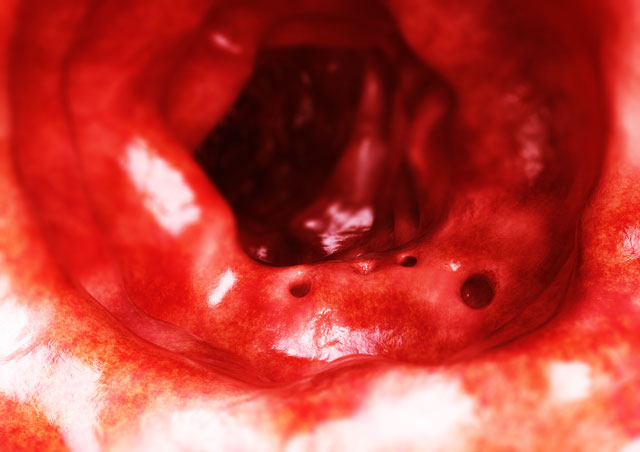
Another study found NSAIDs can induce gluten sensitivity. (22)
NSAIDs include aspirin, celecoxib (Celebrex), diclofenac (Cambia, Cataflam, Voltaren-XR, Zipsor, Zorvolex), diflunisal, etodolac, ibuprofen (Motrin, Advil), indomethacin (Indocin), ketoprofen (Active-Ketoprofen), ketorolac, nabumetone, naproxen (Aleve, Anaprox, Naprelan, Naprosyn), oxaprozin (Daypro) piroxicam (Feldene), salsalate (Disalsate), sulindac, tolmetin.
Equally disturbing is the fact that the anti-inflammatory drugs often do not work very well. All of this information may sound discouraging, however, it needn't be. The good news is Flavay® safely reduces inflammation, edema (swelling) and pain and has been extensively tested in humans and sold worldwide for 70 years.
I have lupus and taking Flavay enables me to move. I'm not able to do without it. I've been taking it for more than a decade and my skin looks younger, in fact people think I'm my kid's sister. —Ms. L.B*
After about 6 to 9 weeks it made a profound difference. I’ve lost inches in swelling. I cannot say enough about Flavay! Over the years, I’ve stopped and started again and found for vascular and lymphatic edema, nothing is better than Flavay. —Ms. Marie D.*
Inflammation is caused by the overproduction of free radicals in a specific area of the body. We now know that antioxidants work together to defeat free radicals and inhibit the biological pathway that triggers inflammation and Flavay® is particularly effective as an anti-inflammatory.
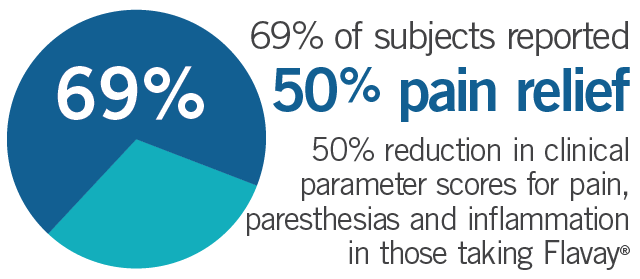
A double-blind, placebo-controlled study of 92 persons with chronic inflammation caused by chronic venous insufficiency (CVI) demonstrated improved venous function at a daily dose of 300 mg Flavay® for 28 days. 69% of those taking Flavay® reported 50% reduction in clinical parameter scores for pain, paresthesias (burning, numbness, tingling, or prickling), nocturnal cramps and swelling (edema). 75% of those taking Flavay® felt it was effective. (20)

The typical recommendation for arthritis is a therapeutic dose of 200 mg to 400 mg of Flavay® daily. Most experience a decrease in symptoms in three to six weeks. In more severe cases, like fibromyalgia, results continue to improve more over more time.
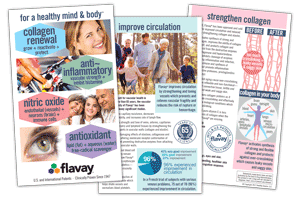
We'll personally answer your questions below, or you may call us at 1-800-200-1203.
To receive a brochure by mail (US only), include your mailing address.
